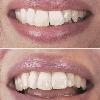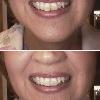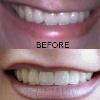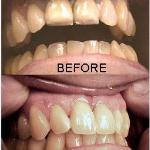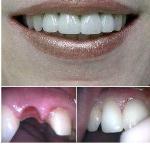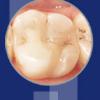

Stanley S Groom DDS WWW.FamilyDentistTulsa.com
Patient Education / Services
Composite Bonding is the most versatile and effective way to aesthetically restore your smile. Composite materials are used to replace old unattractive fillings, change the color of your teeth, or reshape and recontour a less than ideal smile. As you can see in the pictures, although bonding can be used to correct large problems, it is also ideal for small imperfections that many of us would like to correct. Kathy's smile was improved by bonding on the corner of one front tooth, and reshaping of some of the others. Notice how the overall appearance of the face changes in the lower pair of pictures.
Composite resin is a tooth-colored plastic mixture filled with glass (silicon dioxide). Composite fillings have a slightly higher rate of wear than your traditional silver fillings. Most procedures take as little as 10 to 15 minutes per tooth, depending on how complicated your particular treatment may be. At your actual bonding appointment, the dentist will use a mild acid to condition the surface of the tooth so the composite will adhere to it. Next, the dentist applies several layers of the bonding material onto the tooth, then uses a light source to set the material. The last step is shaping, smoothing, and polishing the surfaces. Daily hygiene may require more detailed flossing to clean edges at the gum line. As with your natural teeth, cosmetically bonded teeth may chip or stain. A bonded restoration should last 5 to 10 years or more before requiring a touch-up or replacement. The procedure is painless and quick enough to be completed in one visit.
Veneers are ultra-thin sculpted pieces of tooth-shaped porcelain that fit over the front of your teeth. They are wonderful for fixing teeth that are significantly discolored, chipped, pitted, malformed, or crooked, or if you have unwanted spaces. In certain situations, a change in upper lip fullness and balance can be obtained by placing porcelain laminate veneers on your four front teeth. In the picture, the natural teeth do not do a very good job of filling the spaces or lining up with the face. Placement of veneers allows harmony with the individuals unique features to be attained. Can you tell which teeth were veneered?
Unlike crowns or caps, porcelain laminate veneers don't require the removal of much tooth structure. Veneers are usually created in a dental laboratory from an impression taken in the dental office. During the first visit, the color is matched using a shade guide then the teeth are filed down a bit. Then the teeth are fitted with temporaries while the veneers are being created at the lab. Then the veneers are cemented directly onto your teeth and polished to a natural, aesthetic smile. Veneers are stronger and have a longer life than bonding, but the process requires more time. Veneers typically cost less than crowns and won't stain, making them a popular means of improving your smile. Treatment may take two or more office visits to complete and will last for up to 15 years.
5801 E. 41st Street Suite 500 Tulsa, OK 74135-5619
( NW Corner of 41st and Skelly Drive )
Telephone: (918) 628-0311
email:drstan@familydentisttulsa.com
frontdesk@familydentisttulsa.com
Crown Restorations are similar to veneers, because they too are attached to individual teeth. Crowns completely cover the tooth on all sides, helping to correct any problems that you might have with alignment. Crowns are used to repair teeth that have undergone root canals, have severe erosion, or extreme malposition. The use of crowns is essential in any situation that requires greater strength and aesthetics. Crowns are fabricated from ceramic or ceramic and metal, and are indistinguishable from adjacent teeth. The top picture shows the old worn-out restorations that existed before treatment. Just below are two new all ceramic crowns on the front teeth.
Having crowns applied takes two or three appointments so that your teeth can be prepared and impressions can be made. The impressions are used to fashion a porcelain crown that fits into the contour of the remaining teeth. While your permanent crowns are being created in a laboratory, you'll wear temporary crowns that maintain your appearance and ability to function. Often crowns are added to existing teeth to create better connecting surfaces for attachment of fixed bridges and partial dentures. As with all treatments, crown restorations require meticulous oral hygiene; proper brushing and flossing techniques are effective in eliminating plaque and bacteria. Crowns or caps can last the longest compared to other treatments depending on placement and forces placed on them.
Bridges are useful as corrective measures after an accident or serious dental decay. These restorations-generally made of porcelain or a composite material often over a gold framework- are used to replace missing teeth. Bridges are a method by which to restore your bite and create a pleasant smile. It takes one appointment to prepare the area and another to affix the bridge once it comes back from the lab. Fixed bridges are placed on the neighboring teeth, so they span the site of the missing tooth. The bridge is fitted with ceramic teeth to replicate the missing teeth, to restore function, and aesthetics. The bridge in the picture however is affixed to the 2 middle teeth and one to the patients left while it replaces the tooth just to the patients right, which was lost in an accident. A place for a false tooth in the gum was formed by a temporary bridge. You can see how the new false tooth is inserted.
Removable bridges (also known as partial dentures) are recommended in complex dental situations to restore support and proper function. These bridges are constructed of plastic and metal and require creation of a study model made from impressions. The bridge is also fitted with ceramic or plastic teeth to replicate the missing teeth and combined with metal that is shaped to fit the inside contours of the mouth. Multiple visits are required for adjustments to the bite and fit of the appliance. Fixed bridges require meticulous cleaning usually with a threading floss. Removable bridgework requires meticulous cleaning after meals and soaking in a solution to remove plaque and bacteria.
DDS
Inlays and Onlays are used to replace your silver fillings. These restorations are usually made from composite resin material, porcelain, or gold. Once placed, they are virtually undetectable in the mouth, and they conserve much of your natural tooth structure.
For an inlay to be successful, it is best if the cavity involves only the occlusal surface (chewing surface) and one proximal surface (surface in between the teeth).
Teeth Whitening Your dentist can whiten teeth dramatically using various forms of hydrogen peroxide. One form, carbamide peroxide, is most often used in the form of a gel, and placed into a special tray that is custom-fitted to your teeth. The tray is worn in the mouth for one to four hours per treatment. When in contact with the teeth, the carbamide peroxide releases oxygen that releases the stain on your teeth. This process is safe and effective with only a few temporary side effects. This treatment can be applied at home under periodic supervision by your dentist.
Dentist-Assisted Bleaching utilizes highly concentrated carbamide peroxide that is brushed directly onto the teeth, then a custom-fitted bleaching tray is placed. The high concentrations of peroxide can cause irritation to the surrounding gum tissue and should only be applied by a professional. Most often, this procedure is used followed by additional treatments applied at-home by the patient. Power Bleaching utilizes highly concentrated hydrogen peroxide in a carefully applied solution. A heat or light source is used to activate or accelerate the whitening process. This treatment creates the most dramatic results and is used for people with severe discoloration. Treatments can last seven to ten years, depending on your habits. Ask your dentist to evaluate your smile and decide which treatment is best for you!
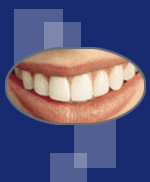
TMD / TMJ People who suffer from symptoms such as headaches, earaches, tenderness of the jaw muscles, or dull, aching facial pain may suffer from TMD-temporomandibular joint disorders. The muscles and joints may not function properly, resulting in cycles of pain and spasms. These disorders can have a variety of causes and, can be treated. You may also have a damaged jaw joint due to injury or disease. Since TMD symptoms (eg, tooth clenching or grinding, headaches, jaw pain or discomfort, clicking, grating, difficulty in closing your jaw) can lead to more serious conditions, early detection and treatment are important.
No one treatment can resolve TMJ disorders completely, and treatment takes time to be effective. We have, however had great success with a new device called the NTI-Tension Suppression System, pictured before and during fitting in the two lower pictures. This device has been used in our practice since January of 2000 for TMD/TMJ. Recently, the FDA has also found the NTI-tss to be safe and effective for Migraine Headache prevention. This news was recently reported on ABC's Good Morning America by Diane Sawyer. For links to this story and more information, see our ACTIVITIES/LINKS page.
Misalignment of the jaw can be corrected using different devices applied by your dentist or an orthodontist. Treatment is based on determining the underlying cause of the problem and correcting it, if possible. In many cases the underlying cause is excessive contraction of the chewing muscles, especially at night. The best correction for this is a device that reduces the intensity of these contractions like the NTI. Anti-inflammatory medications (NSAIDS) can help to reduce inflammation in the jaw. Muscle spasms or muscle tension may be relieved by using moist heat packs on the affected area. A diet of soft foods is recommended. Biofeedback or relaxation exercises may also be effective. Surgery of the jaw is rarely required.
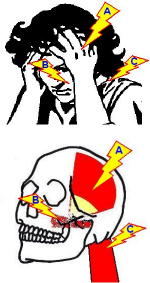
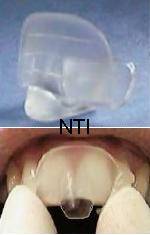



Submit Express Inc.Submit Express

